The Influence of Ink Chemistry on the Microstructure Evolution and GHz RF Response of Printed Ag Transmission Lines
Abstract
1. Introduction
2. Materials and Methods
2.1. Materials and Direct Write Setup
2.2. Post-Print Thermal Treatment
2.3. Characterization of Electrical Properties, Microstructural, and Chemical Evolution
2.4. RF Measurement Setup
3. Results and Discussion
3.1. Electrical Resistivity
3.2. Thermally Driven Microstructural and Chemical Evolution
3.3. RF Performance after Heat Treatment
4. Conclusions
Author Contributions
Funding
Institutional Review Board Statement
Informed Consent Statement
Data Availability Statement
Conflicts of Interest
References
- Rosker, E.S.; Sandhu, R.; Hester, J.; Goorsky, M.S.; Tice, J. Printable Materials for the Realization of High Performance RF Components: Challenges and Opportunities. Int. J. Antennas Propag. 2018, 2018, 9359528. [Google Scholar] [CrossRef]
- Jiang, P.; Ji, Z.; Zhang, X.; Liu, Z.; Wang, X. Recent Advances in Direct Ink Writing of Electronic Components and Functional Devices. Prog. Addit. Manuf. 2018, 3, 65–86. [Google Scholar] [CrossRef]
- NScrypt—Precision Microdispensing and Direct Digital Manufacturing. Available online: https://www.nscrypt.com/ (accessed on 11 March 2023).
- Gibson, I.; Rosen, D.; Stucker, B. Additive Manufacturing Technologies: 3D Printing, Rapid Prototyping, and Direct Digital Manufacturing, 2nd ed.; Springer: New York, NY, USA, 2015; pp. 1–498. [Google Scholar] [CrossRef]
- Vaezi, M.; Seitz, H.; Yang, S. A Review on 3D Micro-Additive Manufacturing Technologies. Int. J. Adv. Manuf. Technol. 2013, 67, 1721–1754. [Google Scholar] [CrossRef]
- Deffenbaugh, P.; Church, K.; Goldfarb, J.; Chen, X. Fully 3D Printed 2.4 GHz Bluetooth/Wi-Fi Antenna. Int. Symp. Microelectron. 2013, 2013, 000914–000920. [Google Scholar] [CrossRef]
- Rodriguez, R.X.; Church, K.; Chen, X. Heterogeneous Process Development for Electronic Device Packaging with Direct Printed Additive Manufacturing. In Proceedings of the 2012 45th International Symposium on Microelectronics, IMAPS, San Diego, CA, USA, 20 August 2012. [Google Scholar]
- Carranza, G.T.; Robles, U.; Valle, C.L.; Gutierrez, J.J.; Rumpf, R.C. Design and Hybrid Additive Manufacturing of 3-D/Volumetric Electrical Circuits. IEEE Trans. Compon. Packag. Manuf. Technol. 2019, 9, 1176–1183. [Google Scholar] [CrossRef]
- Joshi, P.C.; Dehoff, R.R.; Duty, C.E.; Peter, W.H.; Ott, R.D.; Love, L.J.; Blue, C.A. Direct Digital Additive Manufacturing Technologies: Path towards Hybrid Integration. In Proceedings of the FIIW 2012—2012 Future of Instrumentation International Workshop Proceedings, Gatlinburg, TN, USA, 8–9 October 2012; pp. 39–42. [Google Scholar] [CrossRef]
- Benistry, H.; Berger, V.; Gerard, J.-M.; Maystre, D.; Tchelnokov, A. Synthesis of Spatially Variant Lattices. Opt. Express 2012, 20, 15263–15274. [Google Scholar] [CrossRef]
- Chen, X.; Church, K.; Yang, H. High Speed Non-Contact Printing for Solar Cell Front Side Metallization. In Proceedings of the Conference Record of the IEEE Photovoltaic Specialists Conference, Honolulu, HI, USA, 20–25 June 2010. [Google Scholar]
- Deffenbaugh, P.I.; Rumpf, R.C.; Church, K.H. Broadband Microwave Frequency Characterization of 3-d Printed Materials. IEEE Trans. Components, Packag. Manuf. Technol. 2013, 3, 2147–2155. [Google Scholar] [CrossRef]
- Tan, H.W.; An, J.; Chua, C.K.; Tran, T. Metallic Nanoparticle Inks for 3D Printing of Electronics. Adv. Electron. Mater. 2019, 5, 1800831. [Google Scholar] [CrossRef]
- HPS-FG77 Silver Nanoflake Ink—NovaCentrix. Available online: https://www.novacentrix.com/product/hps-fg77-silver-nanoflake/ (accessed on 9 November 2022).
- Sheng, A.; Islam, A.; Khuje, S.; Yu, J.; Tsang, H.; Bujanda, A.; Ren, S. Molecular Copper Decomposition Ink for Printable Electronics. Chem. Commun. 2022, 58, 9484. [Google Scholar] [CrossRef]
- Walker, S.B.; Lewis, J.A. Reactive Silver Inks for Patterning High-Conductivity Features at Mild Temperatures. J. Am. Chem. Soc. 2012, 134, 1419–1421. [Google Scholar] [CrossRef]
- Kim, D.; Jeong, S.; Park, B.K.; Moon, J. Direct Writing of Silver Conductive Patterns: Improvement of Film Morphology and Conductance by Controlling Solvent Compositions. Appl. Phys. Lett. 2006, 89, 264101. [Google Scholar] [CrossRef]
- Williams, N.X.; Noyce, S.; Cardenas, J.A.; Catenacci, M.; Wiley, B.J.; Franklin, A.D. Silver Nanowire Inks for Direct-Write Electronic Tattoo Applications. Nanoscale 2019, 11, 14294–14302. [Google Scholar] [CrossRef]
- Electroninks: Products Particle-Free Conductive Inks. Available online: www.electroninks.com (accessed on 11 March 2023).
- DuPontTM. Kapton® Summary of Properties. 2021. Available online: https://www.DuPont.com/content/dam/DuPont/amer/us/en/ei-transformation/public/documents/en/EI-10142_Kapton-Summary-of-Properties.pdf (accessed on 11 March 2023).
- Coble, R.L. Sintering Crystalline Solids. I. Intermediate and Final State Diffusion Models. J. Appl. Phys. 1961, 32, 787–792. [Google Scholar] [CrossRef]
- Wang, C.; Li, G.; Xu, L.; Li, J.; Zhang, D.; Zhao, T.; Sun, R.; Zhu, P. Low Temperature Sintered Silver Nanoflake Paste for Power Device Packaging and Its Anisotropic Sintering Mechanism. ACS Appl. Electron. Mater. 2021, 3, 5365–5373. [Google Scholar] [CrossRef]
- Mullins, W.W. Theory of Thermal Grooving. J. Appl. Phys. 2004, 28, 333. [Google Scholar] [CrossRef]
- Rios, P.R. Overview No. 62 (A Theory for Grain Boundary Pinning by Particles). Acta Metall. 1987, 35, 2805–2814. [Google Scholar] [CrossRef]
- Fang, Z.Z.; Wang, H. Densification and Grain Growth during Sintering of Nanosized Particles. Int. Mater. Rev. 2013, 53, 326–352. [Google Scholar] [CrossRef]
- Lange, F.F. Sinterability of Agglomerated Powders. J. Am. Ceram. Soc. 1984, 67, 83–89. [Google Scholar] [CrossRef]
- Gall, D. Electron Mean Free Path in Elemental Metals. J. Appl. Phys. 2016, 119, 085101. [Google Scholar] [CrossRef]
- Cuevas, F.G.; Montes, J.M.; Cintas, J.; Urban, P. Electrical Conductivity and Porosity Relationship in Metal Foams. J. Porous Mater. 2009, 16, 675–681. [Google Scholar] [CrossRef]
- Schön, G.; Tummavuori, J.; Lindström, B.; Enzell, C.R.; Enzell, C.R.; Swahn, C.-G. ESCA Studies of Ag, Ag2O and AgO. Acta Chem. Scand. 1973, 27, 2623–2633. [Google Scholar] [CrossRef]
- Hammond, J.S.; Gaarenstroom, S.W.; Winograd, N. X-ray Photoelectron Spectroscopic Studies of Cadmium-and Silver-Oxygen Surfaces. Anal. Chem. 1975, 47, 2193–2199. [Google Scholar] [CrossRef]
- Gaarenstroom, S.W.; Winograd, N. Initial and Final State Effects in the ESCA Spectra of Cadmium and Silver Oxides. J. Chem. Phys. 2008, 67, 3500. [Google Scholar] [CrossRef]
- Janardhanan, R.; Karuppaiah, M.; Hebalkar, N.; Rao, T.N. Synthesis and Surface Chemistry of Nano Silver Particles. Polyhedron 2009, 28, 2522–2530. [Google Scholar] [CrossRef]
- Weaver, J.F.; Hoflund, G.B. Surface Characterization Study of the Thermal Decomposition of AgO. J. Phys. Chem. 1994, 98, 8519–8524. [Google Scholar] [CrossRef]
- Rehren, C.; Muhler, M.; Bao, X.; Erti, G.; Schlögl, R. The Interaction of Silver with Oxygen: An Investigation with Thermal Desorption and Photoelectron Spectroscopy. Z. Für Phys. Chem. 1991, 174, 11–52. [Google Scholar] [CrossRef]
- Joyner, R.W.; Roberts, M.W. A Study of the Adsorption of Oxygen on Silver at High Pressure by Electron Spectroscopy. Chem. Phys. Lett. 1979, 60, 459–462. [Google Scholar] [CrossRef]
- Kaushik, V.K. XPS Core Level Spectra and Auger Parameters for Some Silver Compounds. J. Electron. Spectros. Relat. Phenom. 1991, 56, 273–277. [Google Scholar] [CrossRef]
- Chen, X.; Wang, X.; Fang, D. A Review on C1s XPS-Spectra for Some Kinds of Carbon Materials. Fuller. Nanotub. Carbon Nanostruct. 2020, 28, 1048–1058. [Google Scholar] [CrossRef]
- Gao, X.Y.; Wang, S.Y.; Li, J.; Zheng, Y.X.; Zhang, R.J.; Zhou, P.; Yang, Y.M.; Chen, L.Y. Study of Structure and Optical Properties of Silver Oxide Films by Ellipsometry, XRD and XPS Methods. Thin Solid Films 2004, 455–456, 438–442. [Google Scholar] [CrossRef]
- Chiu, Y.; Rambabu, U.; Hsu, M.H.; Shieh, H.P.D.; Chen, C.Y.; Lin, H.H. Fabrication and Nonlinear Optical Properties of Nanoparticle Silver Oxide Films. J. Appl. Phys. 2003, 94, 1996. [Google Scholar] [CrossRef]
- Waterhouse, G.I.N.; Bowmaker, G.A.; Metson, J.B. The Thermal Decomposition of Silver (I, III) Oxide: A Combined XRD, FT-IR and Raman Spectroscopic Study. Phys. Chem. Chem. Phys. 2001, 3, 3838–3845. [Google Scholar] [CrossRef]
- NIST XPS Database, Spectrum Search Result. Available online: https://srdata.nist.gov/xps/Spec_query.aspx?EType=PE&ENE=368.8&ENEERR=1.0&EType1=-1&ENE1=&ENEERR1=1.0&EType2=-1&ENE2=&ENEERR2=1.0&EType3=-1&ENE3=&ENEERR3=1.0 (accessed on 25 April 2023).
- Capwell, J.; Weller, T.; Markell, D.; Dunleavy, L. Modelithics Inc.|Microwave Journal. Available online: https://www.microwavejournal.com/authors/373-j-capwell-t-weller-d-markell-and-l-dunleavy-modelithics-inc (accessed on 8 April 2023).


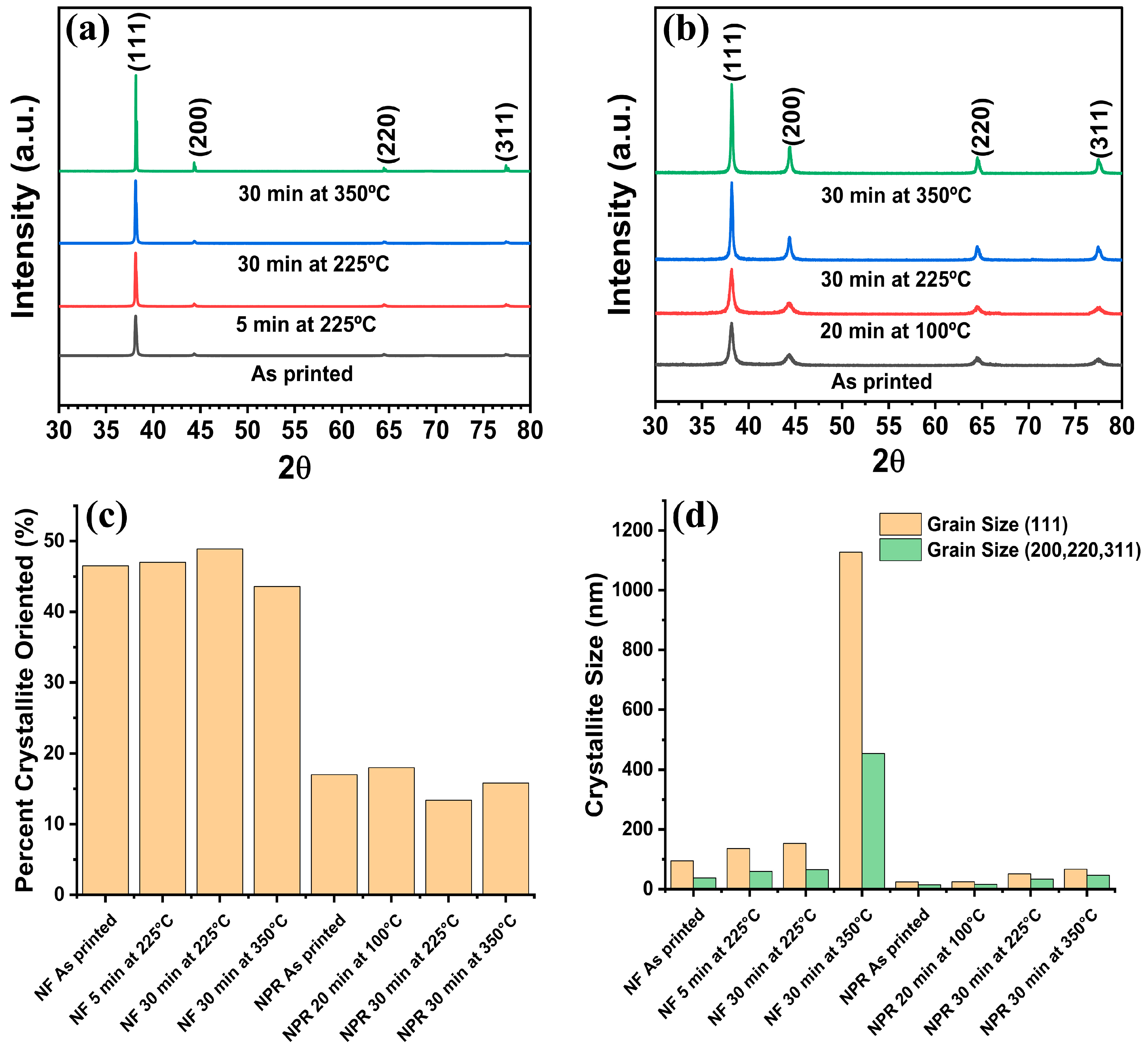
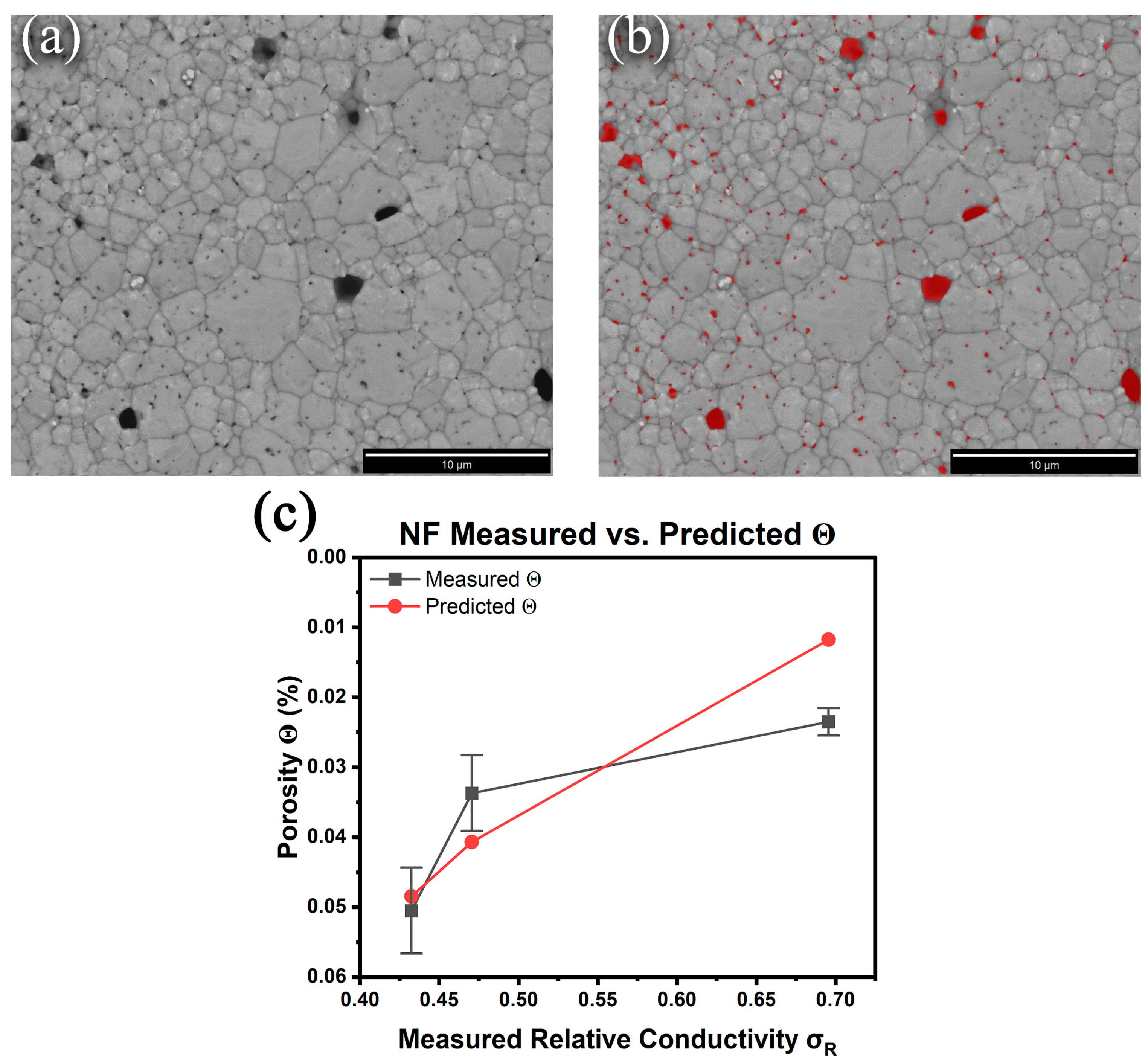
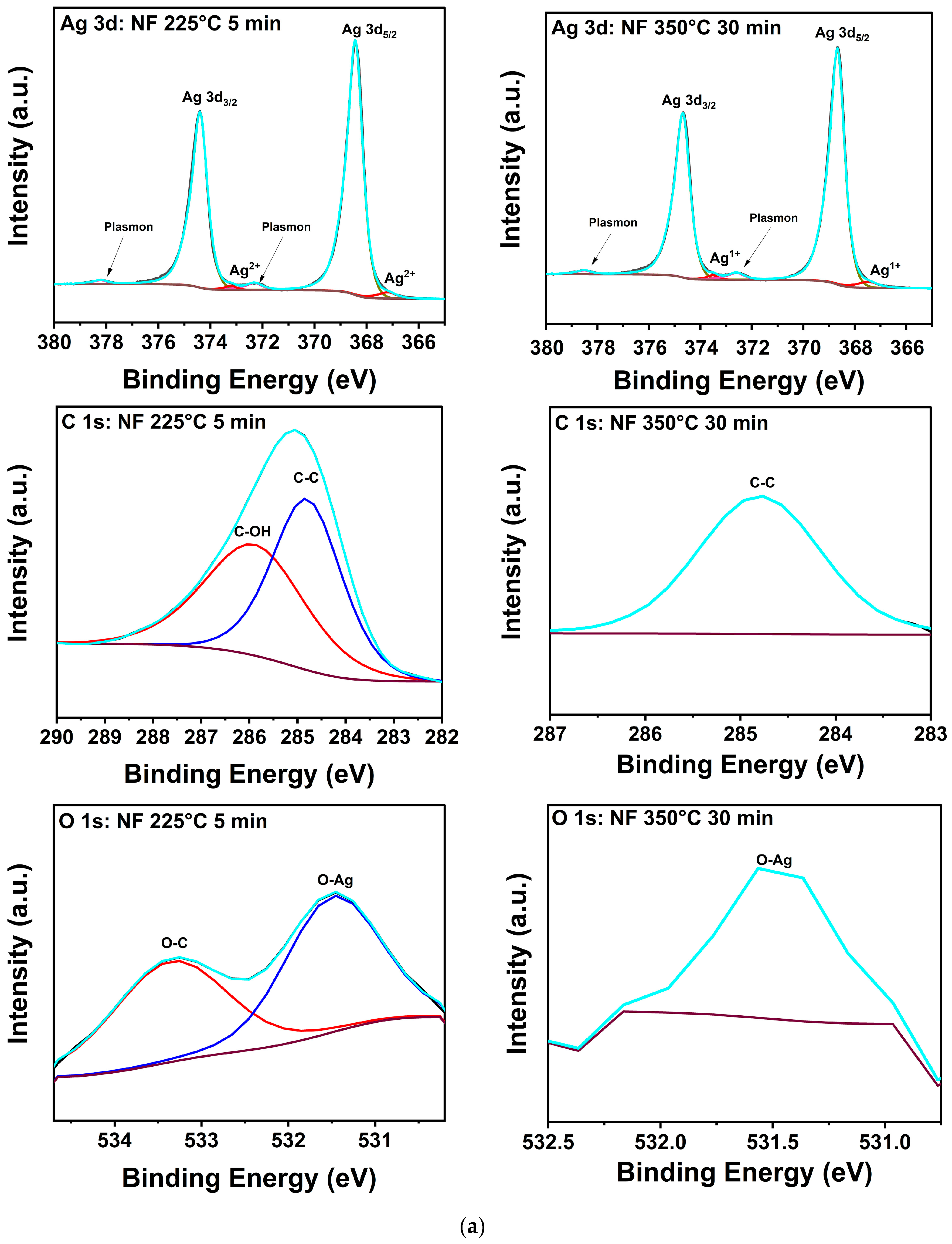
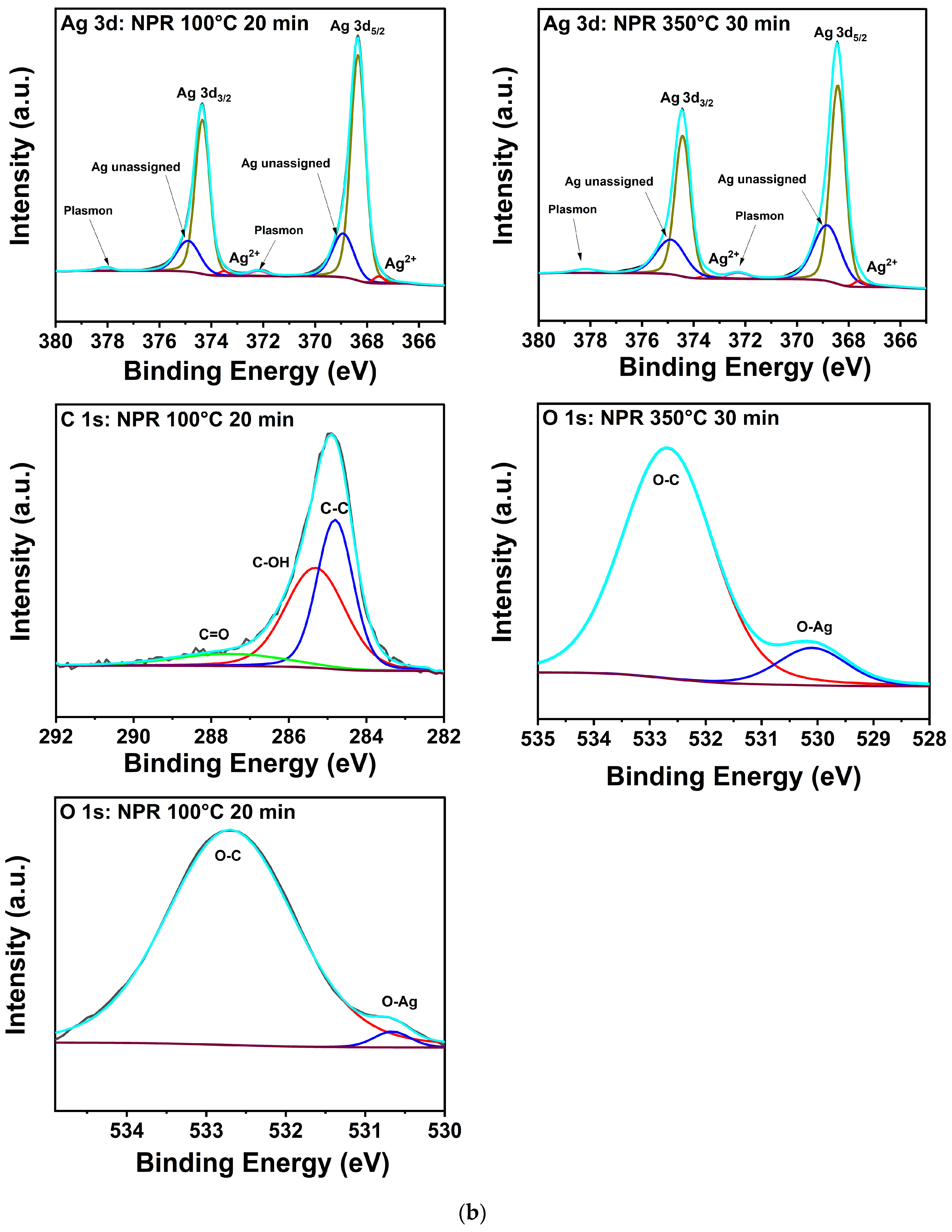
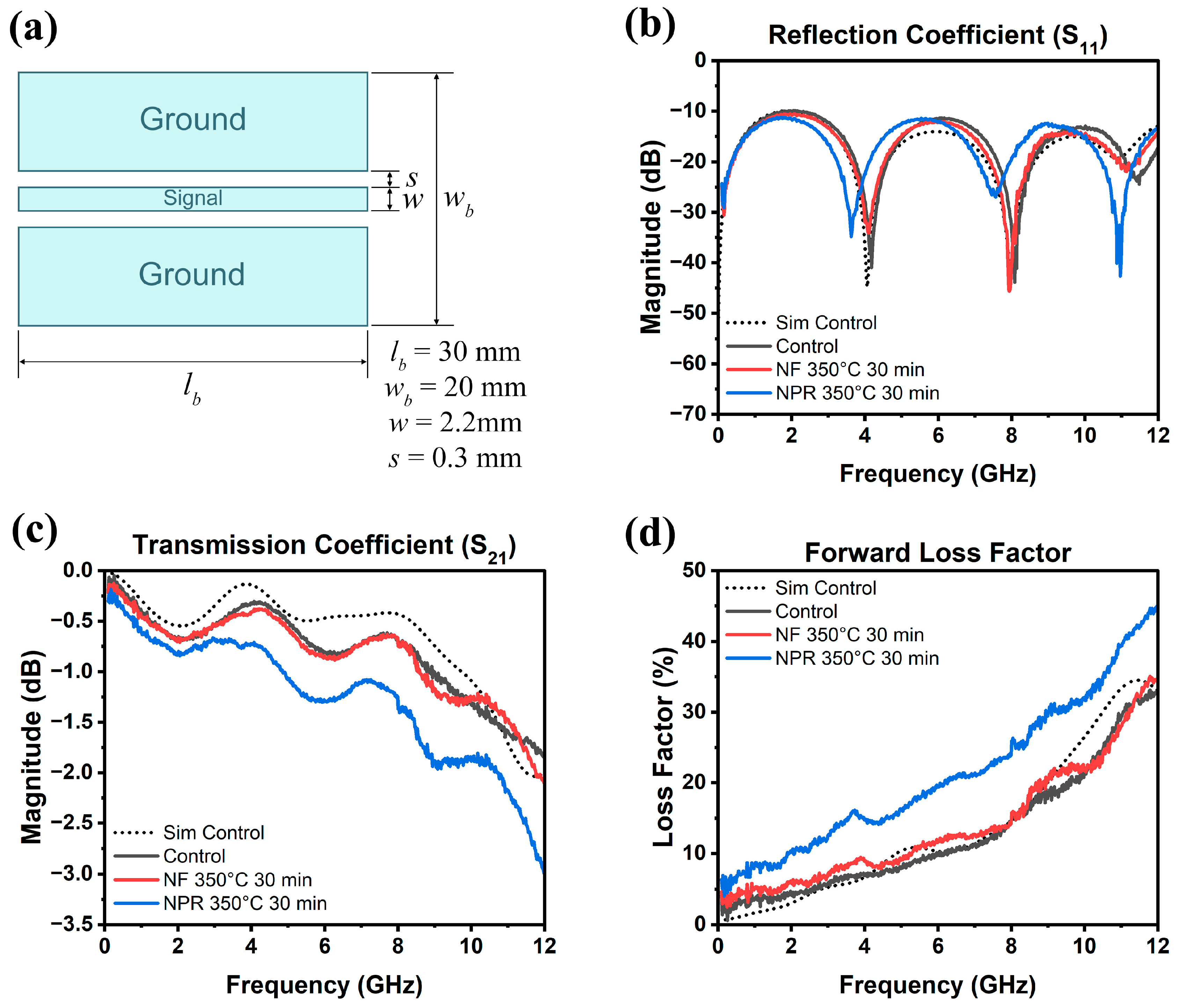

| Nanoflake Suspension (NF) | ||
|---|---|---|
| Treatment | ) | Multiple of bulk Ag ) |
| As printed | 300–800 | |
| Cured per manufacturer’s recommendations for 5 min at 225 °C | 3.7 (±0.1) | 2.3× |
| 30 min at 225 °C | 3.4 (±0.3) | 2.1× |
| 30 min at 350 °C | 2.3 (±0.1) | 1.4× |
| Nanoparticle-reactive (NPR) | ||
| As printed | 21.4 (±2.6) | |
| Cured per manufacturer’s recommendations for 20 min at 100 °C | 7.9 (±0.3) | 4.9× |
| 30 min at 225 °C | 5.7 (±0.2) | 3.7× |
| 30 min at 350 °C | 3.5 (±0.3) | 2.2× |
| Nanoflake Suspension (NF) | |||
|---|---|---|---|
| Treatment | Grain size (111) (nm) | Grain size (111, 220, 311) (nm) | Percent (111) oriented (%) |
| As printed | 95.4 | 37.5 | 46.5 |
| Cured per manufacturer’s recommendation for 5 min at 225 °C | 135.6 | 59.4 | 47 |
| 30 min at 225 °C | 135 | 65 | 48.9 |
| 30 min at 350 °C | 1127.7 | 453.9 | 43.6 |
| Nanoparticle-reactive (NPR) | |||
| As printed | 24.4 | 14.5 | 17 |
| Cured per manufacturer’s recommendation for 20 min at 100 °C | 24.7 | 15.7 | 18 |
| 30 min at 225 °C | 51.2 | 33.9 | 13.4 |
| 30 min at 350 °C | 66.9 | 46.8 | 15.8 |
| Ink | Heat Treatment | % Porosity |
|---|---|---|
| NF | Cured per manufacturer’s recommendation for 5 min at 225 °C | 5.05 ± 0.61 |
| NF | 30 min at 225 °C | 3.37 ± 0.54 |
| NF | 30 min at 350 °C | 2.35 ± 0.19 |
| NF | Peak Position (eV) | Notes |
|---|---|---|
| Ag 3d5/2 | 368.4 | Metal, plasmon at 372.3 eV |
| Ag 3d3/2 | 374.4 | Metal, plasmon at 378.2 eV |
| Ag2+ | 367.2 | AgO |
| Ag2+ | 373.2 | AgO |
| Ag1+ | 367.5 | Ag2O |
| Ag1+ | 373.4 | Ag2O |
| C-O | 285.9 | |
| C-C | 284.8 | |
| O-C | 532.8 | |
| O-Ag | 531.1 | |
| NPR (in addition to the above) | ||
| Unassigned Ag | 368.9 and 374.9 | Ag in remnants of the metal-organic precursors |
| C=O | 287.5 |
| Nanoflake Suspension (NF) | |||
|---|---|---|---|
| Treatment | Atomic % Ag | Atomic % C | Atomic % O |
| As printed | 74.9 | 23.9 | 1.2 |
| Cured per manufacturer’s recommendation for 5 min at 225 °C | 88.9 | 10.7 | 0.4 |
| 30 min at 225 °C | 97.5 | 2.0 | 0.5 |
| 30 min at 350 °C | 99.4 | 0.4 | 0.2 |
| Nanoparticle-reactive (NPR) | |||
| As printed | 86.5 | 10.8 | 2.7 |
| Cured per manufacturer’s recommendation for 20 min at 100 °C | 74.7 | 22.8 | 2.5 |
| 30 min at 225 °C | 95.5 | undetectable | 5.5 |
| 30 min at 350 °C | 91.7 | undetectable | 8.3 |
Disclaimer/Publisher’s Note: The statements, opinions and data contained in all publications are solely those of the individual author(s) and contributor(s) and not of MDPI and/or the editor(s). MDPI and/or the editor(s) disclaim responsibility for any injury to people or property resulting from any ideas, methods, instructions or products referred to in the content. |
© 2024 by the authors. Licensee MDPI, Basel, Switzerland. This article is an open access article distributed under the terms and conditions of the Creative Commons Attribution (CC BY) license (https://creativecommons.org/licenses/by/4.0/).
Share and Cite
Summers, J.M.; Sakri, S.; Chakma, N.; Luyen, H.; Bujanda, A.; Parker, T.; Tsang, H.; Shepherd, N.D. The Influence of Ink Chemistry on the Microstructure Evolution and GHz RF Response of Printed Ag Transmission Lines. Materials 2024, 17, 1756. https://doi.org/10.3390/ma17081756
Summers JM, Sakri S, Chakma N, Luyen H, Bujanda A, Parker T, Tsang H, Shepherd ND. The Influence of Ink Chemistry on the Microstructure Evolution and GHz RF Response of Printed Ag Transmission Lines. Materials. 2024; 17(8):1756. https://doi.org/10.3390/ma17081756
Chicago/Turabian StyleSummers, Jason M., Shambhavi Sakri, Nishako Chakma, Hung Luyen, Andres Bujanda, Thomas Parker, Harvey Tsang, and Nigel D. Shepherd. 2024. "The Influence of Ink Chemistry on the Microstructure Evolution and GHz RF Response of Printed Ag Transmission Lines" Materials 17, no. 8: 1756. https://doi.org/10.3390/ma17081756
APA StyleSummers, J. M., Sakri, S., Chakma, N., Luyen, H., Bujanda, A., Parker, T., Tsang, H., & Shepherd, N. D. (2024). The Influence of Ink Chemistry on the Microstructure Evolution and GHz RF Response of Printed Ag Transmission Lines. Materials, 17(8), 1756. https://doi.org/10.3390/ma17081756







